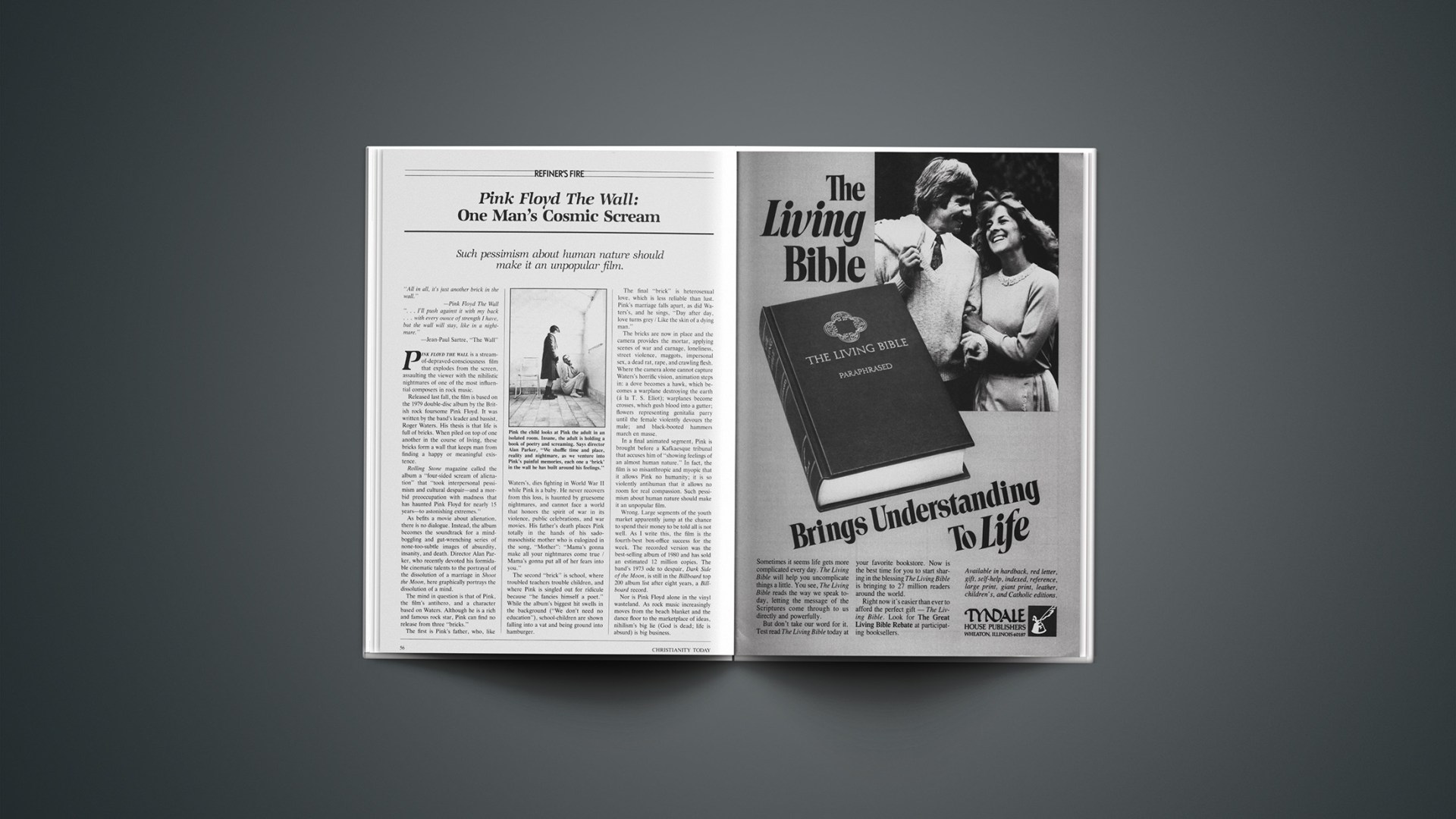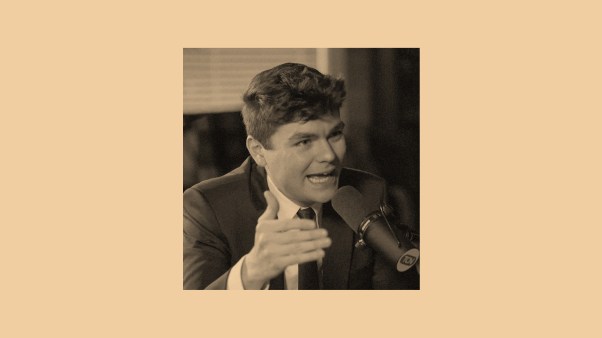Such pessimism about human nature should make it an unpopular film.
“All in all, it’s just another brick in the wall.”
—Pink Floyd The Wall
“… I’ll push against it with my back … with every ounce of strength / have, but the wall will stay, like in a nightmare.”
—Jean-Paul Sartre, “The Wall”
Pink floyd the wall is a stream-of-depraved-consciousness film that explodes from the screen, assaulting the viewer with the nihilistic nightmares of one of the most influential composers in rock music.
Released last fall, the film is based on the 1979 double-disc album by the British rock foursome Pink Floyd. It was written by the band’s leader and bassist, Roger Waters. His thesis is that life is full of bricks. When piled on top of one another in the course of living, these bricks form a wall that keeps man from finding a happy or meaningful existence.
Rolling Stone magazine called the album a “four-sided scream of alienation” that “took interpersonal pessimism and cultural despair—and a morbid preoccupation with madness that has haunted Pink Floyd for nearly 15 years—to astonishing extremes.”
As befits a movie about alienation, there is no dialogue. Instead, the album becomes the soundtrack for a mind-boggling and gut-wrenching series of none-too-subtle images of absurdity, insanity, and death. Director Alan Parker, who recently devoted his formidable cinematic talents to the portrayal of the dissolution of a marriage in Shoot the Moon, here graphically portrays the dissolution of a mind.
The mind in question is that of Pink, the film’s antihero, and a character based on Waters. Although he is a rich and famous rock star, Pink can find no release from three “bricks.”
The first is Pink’s father, who, like Waters’s, dies fighting in World War II while Pink is a baby. He never recovers from this loss, is haunted by gruesome nightmares, and cannot face a world that honors the spirit of war in its violence, public celebrations, and war movies. His father’s death places Pink totally in the hands of his sadomasochistic mother who is eulogized in the song, “Mother”: “Mama’s gonna make all your nightmares come true / Mama’s gonna put all of her fears into you.”
The second “brick” is school, where troubled teachers trouble children, and where Pink is singled out for ridicule because “he fancies himself a poet.” While the album’s biggest hit swells in the background (“We don’t need no education”), school-children are shown falling into a vat and being ground into hamburger.
The final “brick” is heterosexual love, which is less reliable than lust. Pink’s marriage falls apart, as did Waters’s, and he sings, “Day after day, love turns grey / Like the skin of a dying man.”
The bricks are now in place and the camera provides the mortar, applying scenes of war and carnage, loneliness, street violence, maggots, impersonal sex, a dead rat, rape, and crawling flesh. Where the camera alone cannot capture Waters’s horrific vision, animation steps in: a dove becomes a hawk, which becomes a warplane destroying the earth (a la T. S. Eliot); warplanes become crosses, which gush blood into a gutter; flowers representing genitalia parry until the female violently devours the male; and black-booted hammers march en masse.
In a final animated segment, Pink is brought before a Kafkaesque tribunal that accuses him of “showing feelings of an almost human nature.” In fact, the film is so misanthropic and myopic that it allows Pink no humanity; it is so violently antihuman that it allows no room for real compassion. Such pessimism about human nature should make it an unpopular film.
Wrong. Large segments of the youth market apparently jump at the chance to spend their money to be told all is not well. As I write this, the film is the fourth-best box-office success for the week. The recorded version was the best-selling album of 1980 and has sold an estimated 12 million copies. The band’s 1973 ode to despair, Dark Side of the Moon, is still in the Billboard top 200 album list after eight years, a Billboard record.
Nor is Pink Floyd alone in the vinyl wasteland. As rock music increasingly moves from the beach blanket and the dance floor to the marketplace of ideas, nihilism’s big lie (God is dead; life is absurd) is big business.
As this is written, the nation’s number-one single is “Jack and Dianne,” John Cougar’s musical tale of two American kids, with the catchy chorus: “Oh yeah, life goes on / Long after the thrill of living is gone.” A hoard of similar hopeless hits would include: “When the world is running down, you make the best of what’s around,” by the Police; “Running on Empty,” by Jackson Browne; “Had Enough,” by the Who; “Livin’ on the Fault Line,” by the Doobie Brothers; and “Dust in the Wind,” by Kansas. Bob Geldof, who plays Pink in The Wall, is the lead singer for The Boom-town Rats, who had a hit with “I Don’t Like Mondays,” based on the true story of a teen-aged girl who shot down some of her schoolmates.
The church’s response to rock’s godless effusion has itself often been godless, showing God’s hatred for sin but not his love for sinners. After rock singer Ozzie Osbourne bit the head off a bat during a performance, a writer in the Moral Majority Report inaccurately and maliciously wrote, “Fortunately, he contracted rabies so I guess some good came out of it.” A Baptist preacher from Florida evoked Joseph McCarthy, saying he had statistics showing that “of 1,000 girls who became pregnant out of wedlock, 986 committed fornication while rock music was being played.” Some foes hold album bonfires, while others speak of backward masking, said to be an insidious wile of the Devil whereby he captures the souls of those who listen to their rock records played in reverse.
Absent is the approach of the apostle Paul, who reasoned with skeptics and, as Milton pointed out, “thought it no defilement to insert into Holy Scripture the sentences of three Greek poets.” Absent is the desire expressed by Peter, that his readers should always be prepared to explain their hope. Absent is the attitude Francis Schaeffer displayed in his booklet “Art and the Bible.” Looking at Giacometti’s sculpture portraying man’s alienation, Schaeffer said, “I can understand what he is saying and I cry.”
Some walls are so thick that only God’s love can break them down.
STEVE RABEY1Mr. Rabey is a free-lance writer living in Dayton, Ohio.










